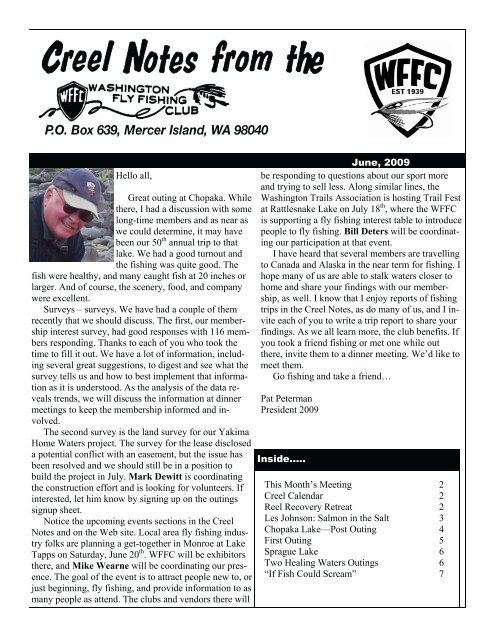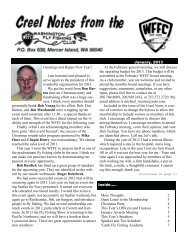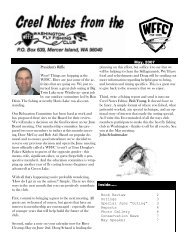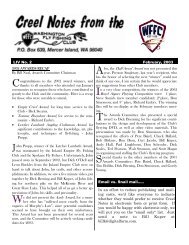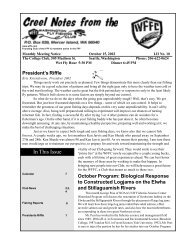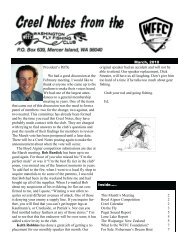You also want an ePaper? Increase the reach of your titles
YUMPU automatically turns print PDFs into web optimized ePapers that Google loves.
Hello all,<br />
Great outing at Chopaka. While<br />
there, I had a discussion with some<br />
long-time members and as near as<br />
we could determine, it may have<br />
been our 50 th annual trip to that<br />
lake. We had a good turnout and<br />
the fishing was quite good. The<br />
fish were healthy, and many caught fish at 20 inches or<br />
larger. And of course, the scenery, food, and company<br />
were excellent.<br />
Surveys – surveys. We have had a couple of them<br />
recently that we should discuss. The first, our membership<br />
interest survey, had good responses with 116 members<br />
responding. Thanks to each of you who took the<br />
time to fill it out. We have a lot of information, including<br />
several great suggestions, to digest and see what the<br />
survey tells us and how to best implement that information<br />
as it is understood. As the analysis of the data reveals<br />
trends, we will discuss the information at dinner<br />
meetings to keep the membership informed and involved.<br />
The second survey is the land survey for our Yakima<br />
Home Waters project. The survey for the lease disclosed<br />
a potential conflict with an easement, but the issue has<br />
been resolved and we should still be in a position to<br />
build the project in July. Mark Dewitt is coordinating<br />
the construction effort and is looking for volunteers. If<br />
interested, let him know by signing up on the outings<br />
signup sheet.<br />
Notice the upcoming events sections in the Creel<br />
Notes and on the Web site. Local area fly fishing industry<br />
folks are planning a get-together in Monroe at Lake<br />
Tapps on Saturday, <strong>June</strong> 20 th . WFFC will be exhibitors<br />
there, and Mike Wearne will be coordinating our presence.<br />
The goal of the event is to attract people new to, or<br />
just beginning, fly fishing, and provide information to as<br />
many people as attend. The clubs and vendors there will<br />
<strong>June</strong>, 2009<br />
be responding to questions about our sport more<br />
and trying to sell less. Along similar lines, the<br />
<strong>Washington</strong> Trails Association is hosting Trail Fest<br />
at Rattlesnake Lake on July 18 th , where the WFFC<br />
is supporting a fly fishing interest table to introduce<br />
people to fly fishing. Bill Deters will be coordinating<br />
our participation at that event.<br />
I have heard that several members are travelling<br />
to Canada and Alaska in the near term for fishing. I<br />
hope many of us are able to stalk waters closer to<br />
home and share your findings with our membership,<br />
as well. I know that I enjoy reports of fishing<br />
trips in the Creel Notes, as do many of us, and I invite<br />
each of you to write a trip report to share your<br />
findings. As we all learn more, the club benefits. If<br />
you took a friend fishing or met one while out<br />
there, invite them to a dinner meeting. We’d like to<br />
meet them.<br />
Go fishing and take a friend…<br />
Pat Peterman<br />
President 2009<br />
Inside…..<br />
This Month’s Meeting 2<br />
Creel Calendar 2<br />
Reel Recovery Retreat 2<br />
Les Johnson: Salmon in the Salt 3<br />
Chopaka Lake—Post Outing 4<br />
First Outing 5<br />
Sprague Lake 6<br />
Two Healing Waters Outings 6<br />
“If Fish Could Scream” 7
This Month’s Meeting<br />
The Creel Calendar<br />
by Steve Sunich<br />
Last chance to attend the WFFC “significant others” meeting. This<br />
features Tom Douglas at the Palace Ballroom on Wed., <strong>June</strong> 17 th , at<br />
5:30 pm (cocktail hour) and 6:45 pm (call to dinner). Remember, this<br />
is a Wednesday, not the typical Tuesday. The Palace Ballroom is at<br />
2100 - 5 th Avenue in downtown Seattle, at the corner of 5 th & Lenora.<br />
The price has been lowered this year to only $33 per person!<br />
To register, just go to the Member area of the WFFC website. If<br />
you do not want to pay online, you can use this form, and send it to<br />
my home address with your check. Otherwise, you can call Steve<br />
Sunich at 425-746-1189 during the day.<br />
Jimmy Green Memorial <strong>Fly</strong> <strong>Fishing</strong> Fair and Casting Expo,<br />
<strong>June</strong> 20 th<br />
From 9 am to 4 pm, at Lake Tye Park in Monroe. Designed to<br />
bring people into the sport. (Ask Leland Miyawaki about it.)<br />
Trail Fest, July 18 th<br />
WFFC will support a fly fishing interest table at the event<br />
sponsored by the <strong>Washington</strong> Trails Association.<br />
2009 Reel Recovery <strong>Washington</strong> State Retreat<br />
by Kris Kristoferson<br />
Reel Recovery’s 2009 <strong>Washington</strong> State Retreat will be held September<br />
14 th to 16 th at Canyon River Ranch, the new lodge south of Ellensburg<br />
and next to Red’s <strong>Fly</strong> Shop. 2009 will mark Reel Recovery’s<br />
fourth year of serving men in <strong>Washington</strong>, thanks to the generous financial<br />
support of both the WFFC and the WFFC Foundation, as well<br />
as the volunteer efforts of many WFFC members who have served as<br />
fishing buddies during the retreats. Be a part of it this year! You can<br />
learn more by visiting the Reel Recovery Web site<br />
(www.reelrecovery.org), or you can contact Kris Kristoferson for<br />
more information.<br />
Creel Notes<br />
...is the official publication of the <strong>Washington</strong><br />
<strong>Fly</strong> <strong>Fishing</strong> <strong>Club</strong>. Subscription is free with<br />
membership.<br />
Jim van de Erve … Editor and Publisher<br />
425-489-0971 jimvde@comcast.net<br />
President<br />
Pat Peterman patpeterman@verizon.net<br />
Co-1st Vice President<br />
Bill Deters detersluksus@comcast.net<br />
Co-1st Vice President<br />
Peter Crumbaker wolf_fenris2nd@hotmail.com<br />
2nd Vice President<br />
Steve Sunich sgsassociatesllc@cs.com<br />
Secretary<br />
Bob Burdick reburdick@comcast.net<br />
Treasurer<br />
Jim Morrison jamescmorrison@mailhome.com<br />
Ghillie(s)<br />
Jim Macdonald macdonaldco@msn.com<br />
Mike Santangelo mikeonthefly@gmail.com<br />
Trustees<br />
Mike Wearne ‘07 Ed Sozinho ‘07<br />
Rocco Maccarrone ‘08 Ed Pettigrew ‘08<br />
Scott Hagen ‘09 Jim Young ‘09<br />
<strong>Club</strong> Aims and Purposes<br />
The purpose of this club shall be:<br />
1. To improve and increase the sport of<br />
<strong>Fly</strong> <strong>Fishing</strong> in the State of <strong>Washington</strong>.<br />
2. To promote and work for the betterment<br />
of trout streams and lakes.<br />
3. To encourage and advocate the conservation<br />
and increase of trout in<br />
state waters.<br />
4. To promote a campaign of education<br />
against pollution in streams, lakes or<br />
Sound waters of the State of <strong>Washington</strong>.<br />
5. To encourage and assist others —<br />
particularly young persons of high<br />
school age—to become fly fishers<br />
and true conservationists.<br />
2
Les Johnson: Salmon in the Salt<br />
by Jim van de Erve<br />
When I’ve fished Puget Sound for salmon, I’ve<br />
dropped a herring down to the bottom. Fish a fly<br />
from a beach in a few feet of water? Yea, right!<br />
But wait. At the May WFFC meeting, Les Johnson<br />
trotted out picture after picture of humongous<br />
salmon caught on a fly from shore. What gives?<br />
Well, Les has been doing it successfully for 50-<br />
some odd years, and he’s written several books to<br />
prove it. For those of us who have been resigned to<br />
dragging bottom, that’s a revelation.<br />
The History<br />
Les admitted at the start of his presentation that<br />
it’s difficult to come up with a program for the club,<br />
because so many members have fished the same waters<br />
for the same fish with many of the same flies.<br />
So, Les started with a history of saltwater salmon fly<br />
fishing. It began with pioneers such as the Stroulger<br />
brothers, who fished out of the Cowichan up on<br />
Vancouver Island in the ‘30’s. They realized: why<br />
wait for the fish to come into the river? Why not go<br />
out to the salt after them? They did so with a famous<br />
fly called the Grey Ghost bucktail. Les showed a<br />
picture of the Stroulger brother with a 22-pound fish<br />
that in those days, according to Les, was average.<br />
Other pioneers included General Noel Money,<br />
renowned fisherman on Vancouver Island in the<br />
‘20’s. And the legendary Roderick Haig-Brown,<br />
who Money mentored. But the movement wasn’t<br />
limited to British Columbia, of course. Pioneers<br />
were also fishing in <strong>Washington</strong> waters. Men like<br />
Enos Bradner, Roy Patrick, Letcher Lambuth, Wes<br />
Drain, and many others—many of them members of<br />
WFFC. “These guys were giants,” Les said.<br />
Les himself got his start back in the ‘50’s. Early<br />
on, he fished with his mother, who loved to catch<br />
coho on herring in Puget Sound. But Les’ mom<br />
couldn’t stand to see Les cut the bait into plugs. One<br />
day, Les took her bucktailing and a large coho<br />
slammed the bucktail fly. They boated a wild 15-<br />
pound native coho, and never fished with another<br />
herring.<br />
Later, Les hooked up with an avid flycaster<br />
named Bruce Ferguson. “He and I spent a lot of<br />
time in the ‘70’s trying to fiddle around with this<br />
fishery,” Les said. “We thought we were creating<br />
it.” He laughs at the audacity of the thought. “We<br />
weren’t.”<br />
Les routinely harkens back to those who went<br />
before. “The thing we miss is how much these guys<br />
brought to the table. We need to appreciate the giants<br />
more than we do.”<br />
Secrets of the Salt<br />
After watching picture after picture of big salmon<br />
caught on flies from the beach, and getting plenty<br />
fired up doing so, the inevitable question was: what<br />
are the secrets of this fishery? Well, Les and Bruce<br />
have recently completed a book entitled, “<strong>Fly</strong>-<br />
<strong>Fishing</strong> for Pacific Salmon II.”<br />
In his presentation to the club, Les spoke about<br />
the baitfish that salmon go bonkers for in the salt,<br />
such as Hyperiid amphipod, which is an important<br />
source of food for coho early in the season. And<br />
sand lance, which is the most popular bait in Puget<br />
Sound. And sardines, shrimp, herring, and smelt.<br />
Les’ book contains many flies originated or tied by<br />
Les or Bruce, and others by club members Letcher<br />
Lambuth, Preston Singletary, Leland Miyawaki,<br />
Richard Embry, Steve Sunich, and others.<br />
Les highlighted the success of flies that have a<br />
pink, vermillion, or orange strip on the median line.<br />
He also said, “When you get close to rivers, you<br />
have to have a selection.”<br />
Where to catch them? Virtually every photograph<br />
that Les showed was of fisherman with big fish on<br />
an isolated beach. Les suggested getting “Walks and<br />
Hikes on the Beaches of Puget Sound”, by Harvey<br />
Manning. About that presumption that salmon feed<br />
and travel in deep water: Not so, says Les. Oftentimes,<br />
salmon would rather feed and travel in shallow<br />
water near the shore. In the book, Les and Bruce<br />
talk about how salmon can find the easiest source of<br />
food by going to a point of land (or an island), especially<br />
where there is an eddy that is down current.<br />
How to find the salmon? Les indicated that you<br />
can often find them by finding baitfish swirling on<br />
the surface near a beach, or by following birds who<br />
are feeding on the baitfish. And in the book, they<br />
say that the most common trigger for salmon to feed<br />
is the tide (with an offset).<br />
After seeing huge salmon after huge salmon, and<br />
hearing how it’s done, it was pretty hard not to get<br />
charged up about this fishery.<br />
3
Chopaka Lake – Post Outing<br />
by Dick Brening<br />
It’s 7:15 on Wednesday morning, the sky is a<br />
light, clear blue, and the temperature is 47 degrees.<br />
The sun has just topped the ridge across the lake and<br />
it is slowly warming me as I sit here sipping my<br />
freshly brewed coffee. The sun is at just the right angle<br />
to make the water in front of my campsite crystal<br />
clear. A large rainbow trout is busily defending his<br />
feeding area next to the old sunken pram. He is<br />
charging at the intruding fish as they search for feed,<br />
trying to drive them from “his” water. He seems to<br />
be doing more defending than eating! A male Rudyduck<br />
with a bright blue beak and a bit of an attitude<br />
swims past looking for a potential mate. The swallows<br />
are making skimming passes over the lake’s<br />
surface, picking off tiny insects, and the familiar call<br />
of the Red-winged Blackbird is clear in the morning<br />
silence. Small insects hover over the water and sporadic<br />
rises dimple the surface across the entire lake.<br />
For most of these rises, the fish don’t even break the<br />
surface; only occasionally do you see a fin or a tail,<br />
but the distinctive “ring of the rise” or the sound of a<br />
“slurp” signals feeding trout. I really need to get out<br />
there soon, but right now this coffee tastes so good!<br />
Don Barton on Chopaka<br />
By Tuesday afternoon, all of the WFFC club<br />
members who were here for the Memorial Day outing<br />
had departed, except for the Lindblooms and the<br />
Brenings. Unlike previous Wednesday mornings following<br />
the outings, when only two or three campsites<br />
would remain occupied, this year every campsite<br />
is filled and will remain that way for the rest of<br />
the week. Another fly club has begun setting up in<br />
the tree-lined arm of the south campground and<br />
members of the Northwest Women’s <strong>Fly</strong>fishing club<br />
are gathering near the large pine tree at the far end of<br />
the north campground. It is certainly not like the welcomed<br />
solitude of previous years! I guess that the<br />
word of the success of the Chopaka Lake rehab has<br />
gotten out. The vehicles of the day fishers are also<br />
beginning to trickle in and crowd the grassy area<br />
above the boat launch. Still, this early in the morning,<br />
there are only two fishermen on the lake. <strong>Fishing</strong><br />
on Chopaka Lake is a late morning activity. I<br />
think I’ll just enjoy the scenic beauty and the warmth<br />
of the sun for a while longer. Now, I hear my wife,<br />
Marje, and son, Kevin, beginning to move around<br />
behind me.<br />
The fishing has changed each day since I arrived.<br />
The Chironomid fishers are doing the best with daily<br />
fish counts well into the twenties. For me, slowly<br />
mooching a large fly at the end of my sink-tip line<br />
worked best during the days of the outing. My son<br />
tied up a large fly that worked well, he called it<br />
“Spirale”. It is similar to the Thin Mint pattern. It is<br />
very colorful and represents I know not what. On<br />
Monday, just by luck, I took a 16-inch long rainbow<br />
on a dry mayfly imitation (Dick Thompson’s Upright<br />
Moose Mane Sub-shank Parachute), but saw no mayfly<br />
duns. Tuesday afternoon, although there were no<br />
visible rises for naturals, I was able to get some very<br />
impressive and splashy takes on my mayfly emerger<br />
pattern cast to within a foot or two of the reeds. In<br />
the south-facing bay across from the campground, I<br />
landed nine rainbows using that pattern in a little<br />
over two hours. They were good-size fish, ranging<br />
between 16 and 19 inches. I saw only an occasional<br />
mayfly dun on the water, but there were reports of a<br />
heavy mayfly hatch near the reeds along the campground<br />
shore.<br />
Wednesday, the damsels arrived. At around noon<br />
I was fishing the reed beds south of the campground<br />
and the reed stalks quickly became covered with tan<br />
damsels drying their wings. The big fish moved in<br />
for the feed and I had a lot of activity. I found that<br />
4
the best fly in my box that day was a pattern similar<br />
to my successful mayfly emerger from yesterday,<br />
only this one was tied without a hair tail, just a single<br />
strand of Crystal Flash (which was my attempt to<br />
give it a trailing shuck). Unfortunately, I was only<br />
two for eight in getting these big fish to my net.<br />
Their aerobatic actions plunging deep into the reeds<br />
were hard to stop and nearly always resulted in a<br />
long-line release, leaving my line tangled among the<br />
reeds. I did have one very aggressive fish (it may<br />
have been my largest fish of the week) take me halfway<br />
into my backing as it headed south along the<br />
shoreline before going airborne and escaping with<br />
my fly and tippet. The trout were all very healthy and<br />
very active when hooked. They ranged in size from<br />
14” to reports of over 20”. The largest fish that I successfully<br />
landed measured 19½”.<br />
Thursday was the only overcast day we had and<br />
fishing for me was very slow. The Chironomid fishers<br />
continued to do well. Friday around noon, the<br />
southerly winds built to such a tempo that it all but<br />
shut down the fishing activity for the rest of the day.<br />
Saturday, we awoke to clear skies, but all the air<br />
mass that moved into B.C. yesterday was now<br />
headed south for Oregon. Reluctantly, we left.<br />
First Outing by Ron Tschetter<br />
I’ve heard more stories about the road leading to<br />
the Chopaka Lake than the fishing. Tales of overheated<br />
cooling systems, broken shock absorbers,<br />
boiling brake lines, flat tires, and worst fates reserved<br />
for vehicles with trailers. Being this was my<br />
first trip to Chopaka, I crept up the steep road slowly,<br />
making sure I had plenty of right hand ‘edge margin’.<br />
I’m a relatively new member of the club, not familiar<br />
with names and faces. So when I drove up to<br />
the Chopaka campsite in a perpetual loop looking for<br />
evidence that I was at the right location, Pete<br />
Baird’s wife Lynn took pity and asked the right<br />
question, “Are you with the club”? Now found, I set<br />
up camp right behind Pete and Lynn’s motor home<br />
for the weekend.<br />
Given that I was unsure of WFFC camp routine, I<br />
figured it was best to watch for crowd development.<br />
When a bunch started to gather under the shelter on<br />
Saturday evening, I knew something was up. Saturday’s<br />
meal was to be an open self-serve barbeque. I<br />
5<br />
watched preparations develop, a charcoal pit dug, a<br />
huge grill laid over the hot coals by Mark Pratt.<br />
Then came a diversity of steaks, chicken, and assorted<br />
other meats brought by members. Other appetizers<br />
began to accumulate, either contributions of<br />
each member’s culinary skills or unique purchases.<br />
Since I didn’t bring anything to cook other than<br />
soup, I missed out on using the charcoal pit. But anyone<br />
who went away hungry, soup or not, had only<br />
themselves to blame.<br />
Naturally I was anxious to get fishing. It seems<br />
the southeast end of the lake attracts the largest cluster<br />
of anglers. That’s where I headed. The end is<br />
shallow and clear enough to see fish with my Polaroids,<br />
lots of them, working the whole area in 8 to<br />
12 feet of water. I noted mostly chironomid fisherman,<br />
bobbers floating straight out in front of them<br />
with those zombie stares. Since I’d had some success<br />
with chironomids in the past (and I’ve learned that<br />
you have to have success with them or most fishermen<br />
will not even try them), a chironomid lash-up<br />
would be my starting ticket. I rigged up a 14’ leader<br />
with a black size-12 tungsten chronomid and no<br />
sooner got it in the water than I got a fish. But that<br />
was it, no more bobber movement. I then changed<br />
color, bang, immediately another fish, then same<br />
thing, nothing. I never really figured out what size or<br />
color the fish were actually taking. I had to change<br />
color or size periodically to get any consistent action.<br />
I also experimented with a number of wet flies. Same<br />
business, you could fool them once, and then better<br />
switch to something else to capture their attention.<br />
Again, I took my queue as a gathering commenced<br />
around the shelter late Sunday afternoon.<br />
This evening was the tempera fish fry night. I was<br />
wondering, how in the earth are they going to cook<br />
deep fry for all these people? Answer, 10 lbs of cod<br />
cut into bite sized chunks then dipped in a tempera<br />
batter. Chief pilot and chef Jim McRoberts was<br />
armed with a propane deep fryer set to churn out<br />
piece after piece of delicious pieces of cod for the<br />
whole group. Pete Baird took over as co-pilot/chef<br />
and continued the feast till the last morsel of cod was<br />
done. More salsa, salads, chips, brownies, pie, even<br />
ice cream continued throughout the evening, adding<br />
to everyone’s waistline.<br />
I don’t think people realize how unusual it is to<br />
get a crowd together like this, a tribute to the tradition<br />
of this club. We had quite a number. I’m sure<br />
everyone caught fish. I’d give the fishing a mark of
(Continued from page 5)<br />
very good. Nice size fish, too, many in the 13” to<br />
16” range and a few (I accurately measured) at a<br />
little over 19”. Not bad for a lake that had been rehabilitated<br />
only 1½ years ago.<br />
I gave myself plenty of left-hand “edge margin”<br />
on the way down the steep road, keeping my old<br />
Explorer in low. The road is really no problem as<br />
long as you take it slow.<br />
Lesson number one for new members: Go on an<br />
outing. It’s the only way to really match names with<br />
the faces and meet some really wonderful people.<br />
Sprague Lake, May 15 th and 17 th<br />
by Bob Burdick<br />
In 2007, the WSFW treated Sprague Lake with<br />
Rotenone because of an overgrowth of scrap fish<br />
and a pronounced decline in the quantity and quality<br />
of trout. In 2008, it was planted with 160,000 1½pound<br />
triploids, and this year it was planted with<br />
additional triploids. Later this year, it will be<br />
planted with large-mouth bass, crappie, and catfish<br />
with the goal of restoring the lake to its former<br />
niche as a warm-water lake with good trout fishing.<br />
After reading game department reports, other fly<br />
club reports, and various blogs about how phenomenal<br />
the trout have been growing, and how well it<br />
was fishing, Mike Santangelo and I decided to investigate<br />
and fished it on the above dates. The lake<br />
is 3½ hours of freeway travel from Seattle, and parallels<br />
I-90 on the way to Spokane. It’s accessed by<br />
both a public and private boat launch on its south<br />
side, as well as from two resorts on the lake. Overnight<br />
accommodations can be found at two motels<br />
in the small town of Sprague, and bar and restaurant<br />
food is available there also. It’s open year-around,<br />
and was crystal clear on the days we were there<br />
with eight to ten feet of visibility. It’s five miles<br />
long and about ½ mile wide, with a maximum depth<br />
of 20 feet, and has many shallow bays and a variety<br />
of reed beds. Strangely, it has very little weed<br />
growth, with a rocky, muddy bottom. Water temperature<br />
was 60 degrees. Insect activity was almost<br />
suffocating with various types hatching on the water<br />
and permeating the air, to the point that at times we<br />
almost wished we had mosquito nets. Each day on<br />
the lake, we saw perhaps 15 to 20 gear fishermen<br />
attracted to the bag limit of five fish daily, only two<br />
of which can be over 20 inches, and only two or<br />
three other fly fishermen.<br />
And the fishing was just as touted—phenomenal!<br />
The 1½ pound triploids on the abundant lake feed<br />
had grown to an average size of three pounds and<br />
18 to 20 inches, with this year’s plant averaging 12<br />
to 14 inches. The bigger fish were all footballshaped<br />
with huge bodies, indicating their rapid<br />
growth. They were very active running and slashing<br />
and jumping once hooked, numerous times getting<br />
into our backing, and were silver bright. The biggest<br />
fish, weighing about five pounds, was credited to<br />
Mike. We tried a variety of flies, but chironomids<br />
fished at about 15 feet seemed most productive on<br />
these two days. Despite the cloud of insects on the<br />
water, we saw very little fish surface activity. On<br />
Friday the chironomid bite was on when we started<br />
fishing at noon, and stopped at 3 pm. On Sunday the<br />
chironomid bite didn’t start until 2:30 and was still<br />
going on at 5 pm when we had to stop. Each day we<br />
hooked about ten fish, landing about five.<br />
It’s unclear just how much longer this summer<br />
this lake will remain productive, as it’s sure to<br />
warm up at some point to where the fish are sluggish.<br />
Also on Friday a small part of the lake was<br />
turning over, although we saw no evidence of that<br />
on Sunday. With so little pressure, it’s sure to be<br />
productive in the fall, and again next spring at ice<br />
out when the 2008 plant should grow to 20 to 25<br />
inches.<br />
Two Healing Waters Outings<br />
by Jim McRoberts<br />
On May 9 th (a beautiful day), we had an outing<br />
for the Seattle vets. These six were all from the Post<br />
Traumatic Stress Disorder unit, PTSD. Project<br />
Healing Waters (PHW) headquarters agreed to pay<br />
for us to take the veterans ranging in age from 60+<br />
(Viet Nam) to mid 20’s (current wars) to Trophy<br />
Lake near Port Orchard. The manager and staff at<br />
Trophy Lake made certain we had all the help we<br />
needed to have a great day and we did! Trophy<br />
Lake has six rods, which we used even though we<br />
had several of our own and the ones belonging to<br />
PHW. They gave us a cart with four seats and a luggage<br />
area. We fished two hours in the morning and<br />
three hours in the afternoon. We fished the lower<br />
6
(Continued from page 6)<br />
Book Review by Steve Raymond<br />
"If Fish Could Scream: An Angler's Search for<br />
the Future of <strong>Fly</strong> <strong>Fishing</strong>"<br />
by Paul Schullery<br />
Stackpole, $24.95<br />
The Effects of Project Healing Waters<br />
pond in the morning. Then they provided a sitdown-select-anything<br />
from the menu lunch. In the<br />
afternoon we went to the upper pond. There were<br />
more active fish in this one and they were closer to<br />
shore. Everyone caught fish, some on the flies they<br />
tied themselves! Flies used were woolly buggers,<br />
chironomids, mayfly, and other emergers and comparadun.<br />
Thanks to the PHW volunteers Vicki Hoagland,<br />
Chuck Ballard, Chuck Tye (NW Coordinator for<br />
PHW), Frank Yandrasits, Paul Dieter, and Jim<br />
McRoberts. We also had two therapists from the<br />
Seattle VAMC PTSD unit (Michael Schillo and<br />
Todd Thomas), who drove the vets to the lake.<br />
On May 30 th PHW had another outing. It was a<br />
gorgeous spring day to fish with four in-patients and<br />
one VA staff member, Michael Schillo, from Seattle<br />
VAMC, and two wounded warriors from Ft. Lewis<br />
at Trophy Lake Golf and Casting. While everyone<br />
got into fish, not all were brought to hand, but the<br />
cries of “fish on!” and the bend of the rod were<br />
enough to satisfy everyone! I loved the fact that one<br />
volunteer member noticed that all the volunteers<br />
pretty much “squealed like girls” whenever a fish<br />
was on the end of the line!<br />
Again many thanks to PHW volunteers Chuck<br />
Ballard, Dick Stearns and his brother-in-law, Don<br />
Schroeder, Jim Higgins, Paul Dieter, Larry<br />
Clemons, and Vicki Hoagland for making this day<br />
memorable. The recreational therapists at the Seattle<br />
VA have let us know what a positive impact we<br />
have had on our vets and wounded warriors, and the<br />
volunteers always leave with big smiles!<br />
7<br />
Paul Schullery is the leading fly-fishing historian<br />
of his generation, with many thoughtful and intelligent<br />
books to his credit. In this new one he brings a<br />
historian’s long view to bear on some of the most<br />
contentious issues facing anglers today, including<br />
the ethics of fishing contests and the pros and cons<br />
of catch-and-release fishing.<br />
Schullery also probes deeply into the culture of<br />
fly fishing, examining the cult of the fly-fishing celebrity,<br />
the rivalry between fly fishers and spin fishers,<br />
the impacts of transportation on fishing, the<br />
good and bad effects of dams, and fisheries management<br />
policies in our national parks. In each case, he<br />
frames the issue in its historical context, quoting<br />
works dating back as far as the 16th century, then<br />
assesses where we are today and where we may be<br />
headed next—for fly fishing, he says, “is poised for<br />
continuing and probably accelerated change.”<br />
Readers who keep waiting for Schullery to take<br />
positions on some of these controversial matters will<br />
be disappointed. When he does take a position,<br />
which he does infrequently, it’s almost always<br />
squarely in the middle instead of on one side or the<br />
other. But eventually it becomes clear this book is<br />
not about the author taking positions; it’s about<br />
making readers think about and perhaps re-evaluate<br />
their own positions. In that, it’s admirably successful.<br />
“If Fish Could Scream” is an interesting and provocative<br />
book. It won’t teach you to catch more fish<br />
or tie better flies, but it might help you become a<br />
more thoughtful angler. Not many books can do<br />
that.
<strong>Washington</strong> <strong>Fly</strong> <strong>Fishing</strong> <strong>Club</strong><br />
P.O. Box 639<br />
Mercer Island, WA 98040<br />
www.wffc.com<br />
Stamp<br />
here<br />
<strong>June</strong>, 2009<br />
Meeting Announcement<br />
Meetings are held on the third Tuesday of each month at the Seattle Tennis<br />
<strong>Club</strong>, 922 McGilvra Blvd. E.<br />
The Wet <strong>Fly</strong> hour begins at 5:30 PM and dinner is served at 6:45 PM.<br />
This month: Significant Others Outing on Wed., <strong>June</strong> 17th<br />
Bring your significant other to an extraordinary meal by renowned chef Tom Douglas.


